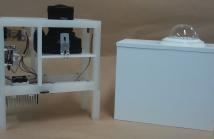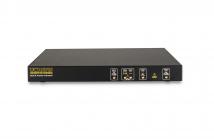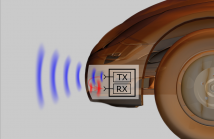- DSP algorithm implementation in hardware and software
- Compilers and tools for DSP implementation
- Algorithm and architecture co-optimization
- Programmable and reconfigurable DSP architectures
- Low-power signal processing techniques and architectures
- System-on-chip architectures for signal processing

- Read more about ICASSP-2018-IOT-L1.4
- Log in to post comments
The emerging compressed sensing (CS) technique enables new reduced-complexity designs of sensor nodes and helps to save overall transmission power in wireless sensor network. Because of the linearity of its encoding process, CS is vulnerable to Ciphertext-Only Attack (COA) and Known-Plaintext Attack (KPA). The prior works use multiple sensing matrices as the shared secret key, however, the complexity overhead of front-end sensor and synchronization issue arising from multiple keys should be well considered.
- Categories:
 16 Views
16 Views- Read more about Transmitter Optimization for MISO System with Service Integration of Multicasting and Confidential Broadcasting
- Log in to post comments
This paper considers a two-user multiple-input single-output Gaussian broadcast channel model with two sorts of information transfer, i.e., multicasting and confidential broadcasting. Specifically, three service messages are combined at the transmitter. The transmitter sends a
multicast message to both users, and a confidential message to each user which is kept perfectly secret from the other user. Our goal
- Categories:
 3 Views
3 Views- Read more about A Mobile EEG System for Practical Applications
- Log in to post comments
In this study, we present a new 64-channel mobile EEG system (NeusenW, Neuracle Inc.), and compare it to a state-of-the-art wired laboratory EEG system and evaluate the EEG signal quality. Previous studies were only performed on seated participants in laboratory environments, and only a very limited number focus on motion conditions. In this study, we instead implemented experiments in standing, walking and running conditions.
- Categories:
 59 Views
59 Views- Read more about Block-wise Lensless Compressive Camera
- Log in to post comments
The existing lensless compressive camera (L2C2) [1] suffers from low capture rates, resulting in low resolution images when acquired over a short time. In this work, we propose a new regime to mitigate these drawbacks. We replace the global-based compressive sensing used in the existing L2C2 by the local block (patch) based compressive sensing. We use a single sensor for each block, rather than for the entire image, thus forming a multiple but spatially parallel sensor L2C2.
- Categories:
 13 Views
13 Views
- Read more about DIY Sky Imager For Weather Observation
- Log in to post comments
In this tutorial, we describe how to design a Whole Sky Imager from off-the-shelf components. Subsequently, we use signal processing techniques to derive instantaneous cloud coverage value from the captured images.
- Categories:
 249 Views
249 Views
- Read more about A HIGH PERFORMANCE BASEBAND INSTRUMENT
- Log in to post comments
Testing complex digital signal processors (DSPs) requires a development platform with sufficient
signal bandwidth and system performance to fully exercise the DSP. Without a development plat-
form, verification of DSPs would be limited to monitoring test output signals for an indication of
performance and successful operation. In addition, a development platform with high-speed analog
input and output interfaces to the DSP system allows it to be used directly in many sophisticated
- Categories:
 8 Views
8 Views
- Read more about Achieving Centimeter Accuracy Indoor Localization on WiFi Platforms: A Frequency Hopping Approach
- Log in to post comments
Indoor positioning systems are attracting more and more attention from the academia and industry recently. Among them, approaches based on WiFi techniques are more favorable since they are built upon the WiFi infrastructures
available in most indoor spaces. However, due to the bandwidth limit in mainstream WiFi systems, the indoor positioning system leveraging WiFi techniques can hardly achieve centimeter localization accuracy under
- Categories:
 32 Views
32 Views
- Read more about Achieving Centimeter Accuracy Indoor Localization on Multi-Antenna WiFi Platforms
- Log in to post comments
Channel frequency response (CFR) is a fine-grained location-specific information in WiFi systems that can be utilized in indoor positioning systems (IPSs). However, CFR-based IPSs can hardly achieve an accuracy in the centimeter level due to the limited bandwidth in WiFi systems. To achieve such accuracy using WiFi devices, we propose an IPS that fully harnesses the spatial diversity in Multiple-Input-Multiple-Output (MIMO) WiFi systems, which leads to a much larger effective bandwidth.
- Categories:
 39 Views
39 Views
Our demonstrator verifies a novel concept to mitigate unwanted close signal reflections in FMCW radar transceivers. In automotive applications, for instance, these reflections originate from the car’s own bumper, causing a severe degradation of detection sensitivity and accuracy due to the unpreventable phase noise contained in the transmit signal. We propose a concept on how to mitigate the so-called Short-Range (SR) leakage in a recently puplished paper in the IEEE Journal of Selected Topics in Signal Processing (December 2015).
- Categories:
 87 Views
87 ViewsIndoor positioning systems (IPS) based on Wi-Fi signals are gaining popularity recently. IPS based on Received Signal Strength Indicator (RSSI) could only achieve a precision of several meters due to the strong temporal and spatial variation of indoor environment. On the other hand, IPS based on Channel State Information (CSI) drive the precision into the sub-meter regime with several access points (AP). However, the performance degrades with fewer APs mainly due to the limit of bandwidth.
- Categories:
 58 Views
58 Views